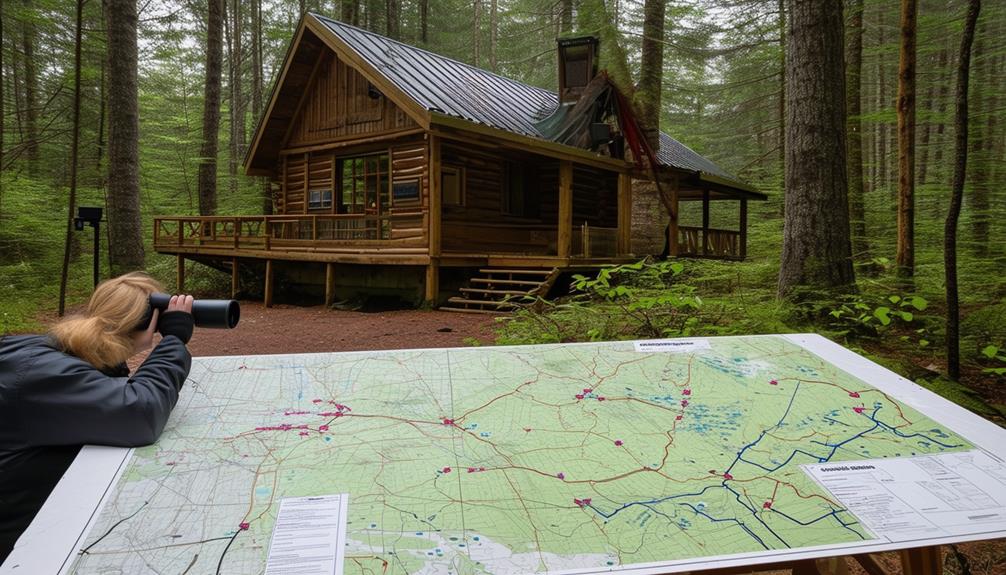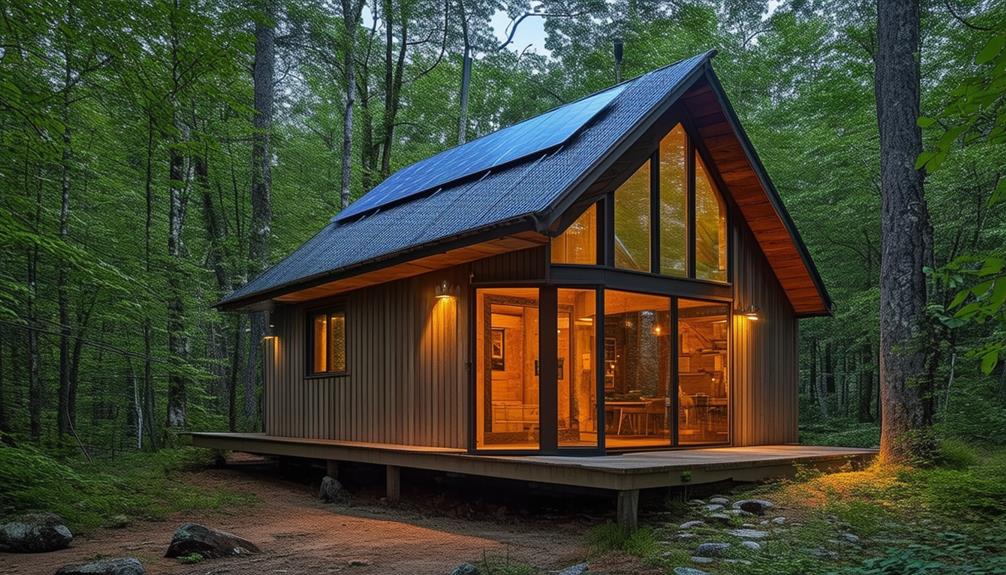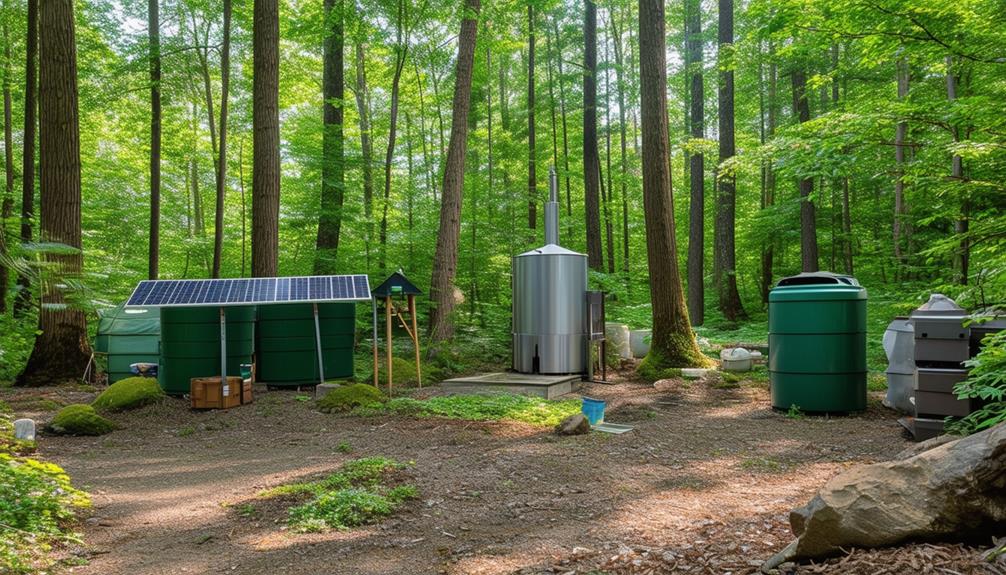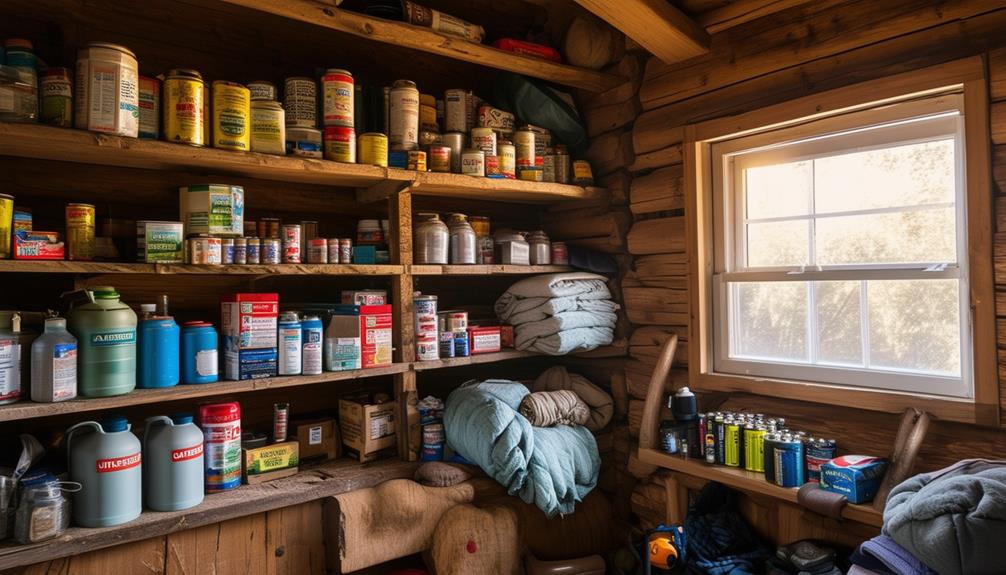How to Maintain and Protect Your Bug Out Location

Maintaining and protecting your bug-out location demands a comprehensive approach. Start with regular security assessments to identify and mitigate vulnerabilities. Reinforce the perimeter and install reliable surveillance systems to monitor your surroundings effectively. Emergency preparedness is crucial: ensure your emergency exits are well-planned and inspect the structure frequently for weaknesses. Water management is also essential; secure a clean, sustainable water source. Balance these needs with maintaining a reliable food supply and sustainable living practices.
Regular Security Assessments

Regular security assessments are essential for identifying vulnerabilities and enhancing the protection of your bug-out location. By frequently evaluating your security measures, you can stay ahead of potential threats and strengthen your defenses.
Begin by examining perimeter defenses to ensure they're robust and intact. Inspect access points like doors and windows for any weaknesses that might be exploited. Identify potential hiding spots that intruders could use. Implement security cameras, motion sensors, and alarms to monitor activity and deter unwanted visitors.
During assessments, be vigilant about signs of wear and tear on structures, fences, and locks, as these could present easy opportunities for breaches if not promptly addressed. Maintaining a log of security incidents, drills, and upgrades is crucial for tracking progress. This record helps identify patterns and areas needing improvement, ensuring your bug-out location remains secure.
Regular security assessments focus not just on finding faults but on continuous improvement. By making necessary adjustments and upgrades, you can create a safer environment for you and your loved ones. Stay proactive and diligent to ensure your bug-out location is always prepared for any situation.
Perimeter Reinforcement
To fortify your bug out location, start by installing robust barriers like fencing, walls, or natural obstacles. Enhance security with surveillance tools such as motion sensor lights, alarms, and cameras to detect intruders early. Regularly inspect these defenses and train your group on how to respond swiftly to any breaches.
Barrier and Fence Setup
Setting up a strong perimeter fence using materials like chain link, barbed wire, or electrified fencing is crucial for deterring intruders from your bug out location. A robust barrier setup not only enhances perimeter security but also plays a vital role in overall protection.
Select durable materials that can withstand various weather conditions and resist tampering. Chain link fences are resilient, while barbed wire and electrified fencing add extra layers of deterrence.
Regular maintenance is essential. Periodically inspect your fence for damage, rust, or weak points, and promptly address any issues to ensure continued effectiveness. Additionally, consider integrating natural barriers such as thorny bushes or dense shrubbery to provide an additional layer of security, making it more challenging for intruders to breach the perimeter.
To further enhance perimeter security, combine physical barriers with tactical elements like guard posts and chokepoints. Strategically positioning these features can create overlapping fields of fire, complicating unauthorized access.
Surveillance and Early Warning
Enhancing your bug-out location with a comprehensive security system, including cameras, motion sensors, and tripwires, significantly improves your ability to detect threats early. These surveillance tools collectively create a robust early warning system, providing real-time visuals, movement detection, and immediate breach alerts.
Security cameras allow you to monitor your perimeter for suspicious activity, while motion sensors trigger alarms in response to movement. Tripwires act as both a physical deterrent and an immediate breach indicator.
To further bolster your perimeter defenses, consider utilizing drones for aerial surveillance. Drones can quickly cover expansive areas and offer a bird's-eye view of your surroundings. Establishing a communication network with nearby allies enhances your early warning capabilities by facilitating the sharing of intelligence on potential threats.
Regularly maintaining fences, barriers, and alarms ensures that your perimeter defenses remain effective. Implementing a buddy system or a rotation schedule for guard duty guarantees constant monitoring of your location.
Surveillance Systems

Enhance the security of your bug out location with a robust surveillance system that offers real-time monitoring and alerts. Surveillance systems serve as the first line of defense against intruders. With continuous live monitoring, you can keep an eye on your property 24/7. Cameras, motion sensors, and alarms work together to detect any suspicious activity. Upon detecting an intruder, you'll receive immediate notifications, allowing for a swift response.
Remote access to your surveillance feeds lets you monitor your bug out location even when you aren't physically present. This feature is especially useful if you need to leave temporarily or want to conduct regular checks. Infrared cameras are particularly effective for nighttime surveillance, ensuring that no activity goes unnoticed in low-light conditions.
Integrating your surveillance system with a central monitoring hub enhances your security even further. The central hub can monitor alerts and ensure a quick response to any threats. This layered approach maximizes your situational awareness and fortifies the security of your location.
Investing in a dependable surveillance system is crucial for maintaining the safety and integrity of your bug out location. Utilizing these technologies can deter intruders and ensure you always have control over your property.
Emergency Exits Planning
When planning your bug out location, ensure you have multiple emergency exits to avoid entrapment during a crisis. Consider alternative routes and exits in different directions so that if one path is blocked or hazardous, you have other options. Regularly review and update your emergency exit plan to account for changes in the environment, such as fallen trees, new structures, or evolving obstacles.
Ensure every group member is familiar with all emergency exits. Conduct periodic evacuation drills to keep everyone prepared and confident about what to do in case a quick escape becomes necessary. These drills will help identify any weaknesses in your plan, allowing you to address them before an actual emergency arises. Keep pathways to emergency exits clear of obstacles and debris to guarantee a quick and safe evacuation. Regularly check and maintain these routes to ensure they remain accessible at all times.
Structure Inspections

How often do you inspect the structures at your bug-out location to ensure they remain secure and reliable? Regular inspections are crucial for identifying any weaknesses or damage that could jeopardize your location's safety. You should examine all buildings, walls, fences, and entry points to verify their structural integrity and fortification against potential threats.
Look for signs of wear and tear, water damage, pest infestations, or any other vulnerabilities that need prompt attention. Addressing these issues through scheduled maintenance can prevent costly damage and enhance your defensive capabilities.
Regular inspections help you stay proactive, ensuring your bug-out location remains a secure refuge. Using inspection checklists and documentation can streamline this process. Track maintenance tasks, prioritize necessary repairs, and maintain a record of your structures' condition over time. This systematic approach not only increases the efficiency of your inspections but also boosts the overall security of your location.
Water Source Maintenance
To ensure a reliable water supply at your bug-out location, regularly test and treat water to keep it safe for consumption. Implement sustainable water storage solutions, such as rainwater collection systems, to supplement your supply. Regularly clear debris and maintain the area around your water sources to prevent contamination.
Regular Water Testing
Regular water testing is crucial to ensure the safety and reliability of your bug out location's water source. By conducting these tests, you can identify potential contaminants such as bacteria, chemicals, and heavy metals, which pose significant health risks if left undetected. Regular testing ensures your water is safe for drinking and other uses, thereby supporting a sustainable living environment.
Start with water testing kits, which are readily available and easy to use. Alternatively, you can hire professional services for a more detailed analysis. Focus on testing for common contaminants like E. coli, lead, and nitrates, as these are frequent culprits of waterborne illnesses. Maintaining a consistent testing schedule allows you to detect problems early and take corrective actions immediately.
Regular water testing not only protects your health but also helps you assess the overall quality and reliability of your water source. A dependable water source is essential for a sustainable bug out location. Neglecting this step could compromise your entire preparedness plan. Stay vigilant and proactive in maintaining your water quality to ensure long-term sustainability.
Sustainable Water Storage
Maintaining a sustainable water storage system is as crucial as regular water testing to ensure a reliable and clean water supply at your bug-out location. Regularly inspect and maintain your water storage containers to prevent leaks and contamination. A compromised container can jeopardize your entire water supply.
Rotate your stored water every six months to maintain its freshness and quality, preventing stagnation and bacterial growth. Incorporate water treatment tablets or filtration systems into your storage protocol to purify water before consumption. This added step will help ensure a safe supply, particularly during extended emergencies.
Investing in larger water storage solutions like WaterBOB or AquaPodKit can be invaluable for ensuring you have enough water for prolonged periods. To protect your water sources from contamination, secure them from animals and debris. Use covers or barriers to keep your storage units clean and uncontaminated. Regularly inspect these barriers for any signs of breach or damage.
Food Supply Checks

Regularly examine your stored food items to identify any spoilage or expired products promptly. Maintaining a dependable food supply is crucial, and frequent checks ensure you have fresh items available. Implementing a detailed inventory system helps you track quantities, expiration dates, and restocking needs efficiently. This system facilitates the rotation of older items to the front and the addition of new supplies to the back, thereby minimizing waste.
Diversifying your food storage is essential. Include a variety of canned goods, dehydrated foods, MREs, and long-lasting staples to ensure variety and balanced nutrition. This diversity helps prevent diet fatigue and maintains nutritional balance in various situations. Additionally, integrating gardening into your emergency plan can provide fresh produce and enhance self-sufficiency.
Use appropriate food storage containers to protect your food supply from pests and environmental factors. Airtight containers, Mylar bags, and food-grade buckets are excellent options for keeping your food safe and extending its shelf life.
- Rotate stock regularly: Ensure older items are used first.
- Track with an inventory system: Monitor quantities and expiration dates.
- Use proper storage containers: Protect food from pests and environmental elements.
Sustainable Living Practices
To effectively maintain your bug-out location, it's crucial to adopt sustainable living practices. Begin by implementing rainwater harvesting systems to collect and store water, ensuring a reliable supply even during dry spells. Complement this with water-saving strategies like low-flow fixtures and greywater recycling to optimize resource conservation.
Utilize renewable energy sources such as solar panels or wind turbines to reduce dependency on non-renewable energy. These systems offer a sustainable and reliable energy source, essential for long-term survival.
Engage in organic gardening and permaculture techniques to grow your own food on-site, ensuring a continuous and healthy supply. Select plants suited to your climate and soil conditions for optimal results. Incorporate composting systems to minimize waste and enrich your soil. Composting reduces your environmental footprint and provides nutrient-rich material to enhance garden productivity.
Waste Management

Proper waste management at your bug-out location is crucial for preserving both the environment and your health. Effective waste disposal systems maintain high hygiene standards and prevent water source contamination, thereby reducing the risk of infections and other health issues.
To set up a comprehensive waste management system, follow these steps:
- Separate Organic Waste: Compost food scraps and biodegradable materials to create nutrient-rich soil.
- Recyclables: Collect items like paper, plastic, and metal separately for recycling.
- Hazardous Waste: Properly dispose of batteries, chemicals, and medical waste to prevent contamination.
Regular waste disposal in designated areas is necessary. Establish a routine for waste collection and educate everyone at your bug-out location about proper waste management practices. This will help maintain cleanliness and prevent waste buildup.
Conclusion
To maintain and protect your bug out location, regularly evaluate your security measures, strengthen the perimeter, and install surveillance systems. Plan emergency exits and inspect structures to ensure readiness. Maintain water sources, inspect food supplies, and practice sustainable living. Effective waste management is also crucial. By following these steps, you can protect and sustain your bug out location, ensuring it remains a reliable refuge in times of need.




